Camino de Santiago - French Way - Stage 8 - Logrońo to Nájera
Total distance: 29 km
Before you leave Logrońo make sure you have had a hearty breakfast and take some lunch and plenty of water with you as the next town called Navarrete is 13 kilometres away and there are very few opportunities to stock up in between.
To leave Logrońo head back towards the Iglesia de Santiago down the Calle Barriocepo through the Casco Antiguo (old town) and leave the old town through an arch in the town's walls called la Puerta del Camino. Continue down Calle de los Depositos past a roundabout with fountains and head down Calle del Marques de Murieta. After a while this road becomes Avenida de Burgos and eventually takes you through a tunnel under the motorway. After about 2 kilometres you will begin to walk through open park land which leads you to a reservoir called Pantano de la Grajera. The path continues along the retaining wall and across a couple of bridges to a picnic area and café bar.
The path follows the edge of the reservoir and along a gravel path and then a dirt track through fields and vineyards and across the motorway. Soon after you come across the restored ruins of the Hospital de Peregrinos founded in 1185 by the Order of San Juan de Acre to administer to the Peregrinos (pilgrims) undertaking the Camino and shortly arrive in the small town of Navarette.
Like so many of the towns along the Rioja/Navarra border Navarette, sitting atop the hill Cerro Tedeón, owes its existence to the Castilian kings wanting to establish a fortress town to defend the border. A castle once stood at the top of the hill and its remains can still be seen.
The area surrounding Navarette is full of dark red clay and within the town you will find a number of pottery factories and workshops. The town is also famous for its Rioja wine, especially the rosé, and has at least 9 bodegas in the vicinity.
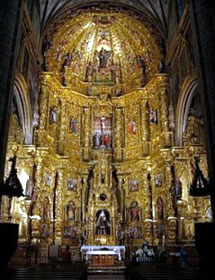
The 16th century Iglesia de la Asunción is worth visiting with its gilded Baroque altarpiece with a statue of St James near the top.
There are several cafés and restaurants offering a pilgrim menu and there are 2 albergues, one private within the town and another private albergue about 1.3 kilometres outside the town in a small village called Sotes. There are also a couple of Hostals for you to stay in.
Upon leaving Navarette, take the road past the Iglesia de la Ascunción and left down Calle Mayor Alta onto the main road passing the cemetery. The 12th century gates to the cemetery were originally part of the Hospital de Peregrinos which you passed on entering the town.
Passing the cemetery the road continues onto a gravel track taking you through some vineyards. From here on in the road is a little awkward, not in terms of difficulty, but it's a little fiddly because it has been designed to try and avoid the very busy N120.
You will soon come to a junction where you have 2 options, keep on to Nájera about 14 kilometres away or take a slight detour into Ventosa, which will add a further 2 kilometres to your journey but where you can get something to eat at the restaurant that offers a pilgrim menu or you have the option of a café and bakery. You could also visit the 16th century Iglesia de San Saturnino Siglo and stay at the albergue just below the church.
If you have chosen to go to Ventosa you will leave the village by an uphill dirt track heading towards the Alto de San Antón and the ruins of the Convento de San Antón, a former convent and pilgrim hospital. Continuing along the dirt track through yet more vineyards you cross the road just right of the Poyo de Roldán. It is here where, in the late 8th century, Roland is alleged to have killed the giant Ferragut.
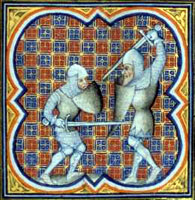
Stories tell us that Ferragut was a Syrian giant said to have been a descendant of Goliath (as in David and Goliath) who had been sent to Spain to fight Charlemagne's Christian army. He is said to have had the strength of 40 men and feared no weapon.
Many of Charlemagne's men were sent to fight the giant and were defeated every time. Finally Roland, one of Charlemagne's knights, was able to approach the giant and fought him for 2 days using anything at his disposal including swords, sticks, bare fists and stones. Despite this Roland was unable to even wound the giant.
On the third day the two men called a truce and sat down to discuss religion. During this conversation, and following the drinking of copious amounts of wine, Ferragut let slip that his weakest point was his navel. The next morning the two men began fighting again and Roland, remembering what the giant had told him the day before, slayed Ferragut by piercing his navel with a spear.
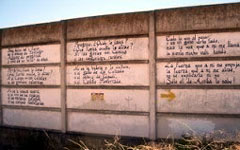
Back on the Camino you will cross a footbridge over the Río Yalde and walk past a gravel factory that has a poem to Pilgrims written on the side.
Click here for the poem in its entirety as well as the English translation.
The path continues through some vineyards which bring you to the outskirts of Nájera. From here follow the signs for the town centre and cross the bridge over the Río Najerilla.
Nájera is an Arabic name which means "between rocks" as the town is situated between rocky crags.
The town is historically important as it had been the base for many of the Navarran kings during medieval times after King Garcia Sanchez chose it as his base. In the early 11th century King Sancho III (the Great) ruled most of northern Spain, from Catalunya to Galicia, from here. Sancho III also modified the Camino route so that pilgrims could rest in Nájera. The town was ceded to the kingdom of Castilla in 1076 when King Sancho IV was killed by his brother Ramón and the kingdom divided.
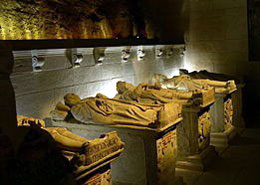
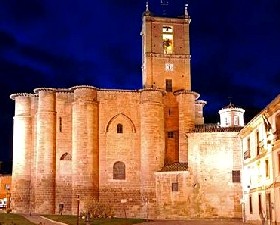
The town is built on the banks of the river Najerilla and along its banks you will find the Monasterio and Iglesia de Santa María La Real. Built in 1032, it has undergone a number of modifications due to damage sustained during the Peninsular war. The church has a Royal Pantheon bearing the tombs of some thirty monarchs including the mausoleum of the Dukes of Nájera. In the crypt you will find something unusual in a church, a cave.
According to legend King Garcia, Sancho's eldest son, was out partaking of a bit of falconry when his bird pursued a dove into a cave. He followed the falcon into the cave and was surprised to find both birds side by side in front of a figure of the Virgin Mary with a vase of fresh lilies at her feet.
Over the next few years King Garcia was successful in a number of battles and he attributed this to the Virgin Mary and therefore decided to build a church in her honour. The siting of the church was to be over the cave where he first received the vision, which explains why there is a cave in the crypt.
If you are into history and archaeology, directly opposite the monastery is the Nájera History and Archaeological Museum.
Nájera is a large town with several bars and cafés and facilities associated with a town of this size. If you wish to stay here there are 2 albergues, one private and one municipal.

